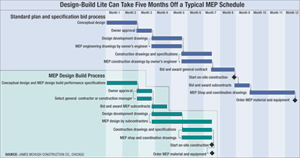
McShane-Fleming Chicago's Blackstone Hotel is undergoing a $112-million renovation.
|
One large midwestern building contractor has found that working with a modified delivery system it calls “design-build lite” is professionally challenging but economically beneficial to all parties. The system can increase speed, coordination and value while reducing risk and problems.
James McHugh Construction Co., Chicago, has worked on a significant number of full design-build projects. Along the way, it discovered that doing mechanical-electrical-plumbing (MEP), fire protection or structural work in a design-build format also is a winner.
After 12 such projects, McHugh says about 75% of its annual $500-million construction volume can be completed using the alternative design-build approach. “Some clients are just not ready for full design-builds,” says Robert W. Soldan, McHugh senior vice president. “But structural and MEP design-build can kick-start a project. It builds flexibility into a demanding job and allows us to play to our strengths.” He says the process “resolves potential conflicts during the construction phase and helps accelerate the preconstruction process.” McHugh only practices design-build lite on projects it controls either as general contractor or construction manager.
Control is important. On a traditional MEP project, the architect hires engineering firms to draw up full plans and specifications. When construction starts, their work is put out to bid. Once subcontractors are selected, they begin producing working and shop drawings.
With design-build lite, McHugh brings in subs after the architect completes conceptual design, long before construction documents are done. Subs bid on a performance specification provided by the owner. This eliminates the need for the owner’s engineers to prepare plans and specs, cutting costs and eliminating a set of documents.
“By the time we break ground, materials are already ordered,” says Soldan. “Also, when subs are working that early in the project, they coordinate locations of piping, ductwork and equipment with the architect’s layouts and drawings.” That reduces potential conflicts between MEP and architectural features. “Architects don’t get involved in redrawing and in questions later on during construction when it gets hectic,” says Soldan.
McHugh is general contractor on a $112-million renovation of the 96-year-old, 22-story Blackstone Hotel in Chicago. A new restaurant will replace an old theater and unfinished space under the mansard roof will become luxury suites. Closed since 1999, the hotel will join the Marriott Renaissance chain when work is complete in late 2007.
| + click to enlarge |
 Design-Build Lite Can Take Five Months Off a Typical MEP Schedule. |
McHugh’s scope of work includes overseeing demolition, interior restoration and facade improvements, but it also involves a design-build MEP contract. “It’s treated just like a traditional MEP. The subs are included as a line item in our guaranteed maximum price budget,” says Soldan. “But we provide additional language in subcontracts to make our subs responsible for system design. Ultimately, we are responsible to the owner.” Weekly meetings with the architect “eliminate finger pointing, claims and change order games,” he adds.
The approach also builds long-term links. James R. Loewenberg, owner of local architect Loewenberg Associates LLC, also acts as owner-developer on design-build lite projects, teamed with Magellan Development Group LLC. “We find it a very effective way of managing total construction costs of our developments,” he says. “We work directly with the mechanical contractors to establish criteria that are incorporated into the overall design. We can target specific equipment use and get the best value.”
Cost savings may not be great, but Loewenberg is assured that things are done right the first time. “The contractor takes on design responsibility, but I save potential cost overruns and extras,” he says. Loewenberg has finished nine MEP design-build-lite projects with McHugh. “We could do all these without design-build lite but we don’t want to,” he says.
Kristopher T. Schwengel, Magellan vice president of construction, also has done four structural design-build-lite projects with McHugh. “We build on a very fast-track basis. It’s very important for us to get budget numbers from a contractor early on, so we identify a short list of structural engineers, which we present to McHugh,” says Schwengel. “We all select the engineer, then use its schematic design to develop the overall budget. Then we’re off to the races.”

McShane-Fleming Studios, Chicago McHugh workers are converting unfinished hotel space into new luxury suites.
|
The budget includes the structure, and because the structural engineer works directly for McHugh, confidence levels are bolstered. “It removes structural design risk out of our business plan and puts it in McHugh’s,” he says. “There isn’t a huge difference in team interaction, but we’re in a better position.”
There also is little schedule difference, except on MEP work. “McHugh brings a team to us to start immediately on permit drawings, a critical path item,” says Schwengel. “We remove time-consuming back and forth between a traditional engineer and a contractor doing value engineering. That alone can save months in preconstruction, which is priceless.”
Design-build lite is spreading. “It’s attractive to owners because it eliminates soft costs but meets their requirements,” Soldan says. Owner apprehension relates to “fear of the unknown, but in most cases that’s misplaced.”
 More from Progressive Project Delivery Special Report
More from Progressive Project Delivery Special Report 

